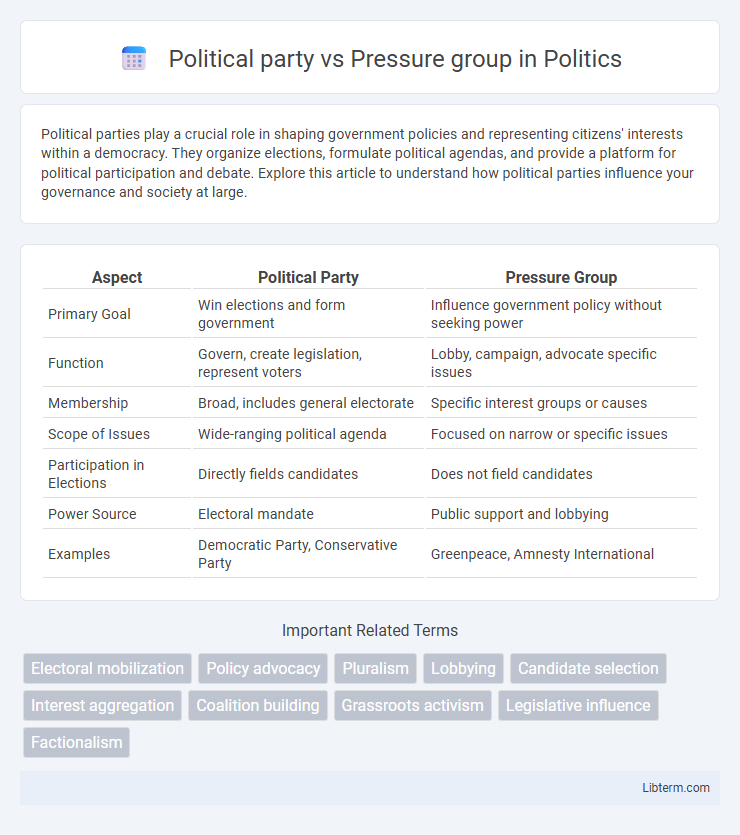Political parties play a crucial role in shaping government policies and representing citizens' interests within a democracy. They organize elections, formulate political agendas, and provide a platform for political participation and debate. Explore this article to understand how political parties influence your governance and society at large.
Table of Comparison
| Aspect | Political Party | Pressure Group |
|---|---|---|
| Primary Goal | Win elections and form government | Influence government policy without seeking power |
| Function | Govern, create legislation, represent voters | Lobby, campaign, advocate specific issues |
| Membership | Broad, includes general electorate | Specific interest groups or causes |
| Scope of Issues | Wide-ranging political agenda | Focused on narrow or specific issues |
| Participation in Elections | Directly fields candidates | Does not field candidates |
| Power Source | Electoral mandate | Public support and lobbying |
| Examples | Democratic Party, Conservative Party | Greenpeace, Amnesty International |
Introduction to Political Parties and Pressure Groups
Political parties and pressure groups both play crucial roles in democratic systems but differ fundamentally in their objectives and functions. Political parties aim to gain governmental power by contesting elections and formulating public policies, whereas pressure groups seek to influence policy decisions without directly seeking electoral office. Understanding their distinct roles helps clarify the mechanisms of representation, political participation, and policy advocacy within political systems.
Definition and Core Functions
Political parties are organized groups seeking to gain and maintain political power by contesting elections and forming governments, with core functions including candidate nomination, policy formulation, and mobilizing voter support. Pressure groups are organizations that aim to influence public policy and decision-making without seeking electoral power, primarily engaging in advocacy, lobbying, and public campaigns to represent specific interests or causes. Both play crucial roles in democratic systems, but political parties focus on governing, while pressure groups concentrate on shaping policies.
Organizational Structure and Membership
Political parties possess a formal organizational structure with elected leadership, local branches, and a broad membership base united by a comprehensive political agenda aimed at gaining governmental power. Pressure groups, also known as interest groups, feature a more flexible and less hierarchical organization focused on specific issues, attracting members who share particular interests or goals without seeking direct electoral control. Membership in political parties tends to be larger and more publicly engaged, while pressure groups often have more specialized, active members concentrated on advocacy and lobbying efforts.
Methods of Operation and Influence
Political parties operate by contesting elections to gain governmental power and implement policy agendas directly, using organized campaigns, candidate selection, and voter mobilization. Pressure groups influence decision-making indirectly by lobbying legislators, organizing demonstrations, and utilizing media campaigns to shape public opinion and policy without seeking elective office. Both employ strategic communication and coalition-building, but political parties focus on governance while pressure groups prioritize targeted advocacy.
Role in Policy Making
Political parties play a central role in policy making by formulating, promoting, and implementing legislation through elected representatives within government institutions. Pressure groups influence policy indirectly by lobbying policymakers, mobilizing public opinion, and providing expert information to shape decisions without seeking electoral power. Both entities impact governance, but political parties possess formal authority to enact policies, while pressure groups act as catalysts for specific interests.
Relationship with the Government
Political parties seek to gain control of government by winning elections and forming policies, directly influencing legislative and executive decisions. Pressure groups do not aim to govern but exert influence on government officials and institutions to shape policy outcomes in favor of specific interests. The relationship between political parties and pressure groups is often collaborative or adversarial, depending on alignment or conflict of interests regarding government agendas.
Sources of Funding and Resources
Political parties primarily rely on membership fees, state funding, and large donations from corporations or wealthy individuals to finance campaigns and organizational activities, ensuring broad resource availability. Pressure groups depend more on membership subscriptions, donations from sympathizers, and grants from NGOs or foreign entities, often limiting their financial capacity compared to parties. The disparity in funding sources impacts the scale and influence, with political parties wielding greater access to media and infrastructure, whereas pressure groups maximize targeted advocacy through grassroots mobilization and expert research.
Impact on Democratic Processes
Political parties significantly shape democratic processes by nominating candidates, formulating policies, and securing governance through elections, thus directly influencing legislative frameworks and public administration. Pressure groups impact democracy by advocating for specific interests or causes, mobilizing public opinion, and holding elected officials accountable without seeking electoral power themselves. Both entities contribute to pluralism and citizen participation, but political parties operate within formal political structures while pressure groups function primarily through lobbying and advocacy.
Key Differences Between Political Parties and Pressure Groups
Political parties aim to gain political power by contesting elections and forming governments, while pressure groups focus on influencing public policy without seeking electoral office. Political parties have broad policy agendas covering multiple issues, whereas pressure groups typically concentrate on specific causes or sectors. Membership in political parties is generally more inclusive and electorally motivated, whereas pressure groups attract individuals united by particular interests or advocacy goals.
Conclusion: Comparative Analysis and Significance
Political parties and pressure groups both influence policymaking but differ fundamentally in structure and objectives; parties seek electoral power to implement broad policy platforms, while pressure groups aim to affect specific issues without contesting elections. The significance of political parties lies in governance and legislative authority, whereas pressure groups play a crucial role in representing diverse interests and shaping public opinion. Understanding their comparative functions highlights the complementary nature of political participation and advocacy in democratic systems.
Political party Infographic

 libterm.com
libterm.com